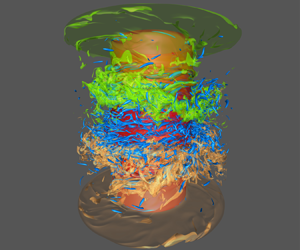Article contents
Flow structures and heat transport in Taylor–Couette systems with axial temperature gradient
Published online by Cambridge University Press: 15 June 2021
Abstract

We investigate the heat transfer and coherent structures in Taylor–Couette (TC) flows that undergo thermal convection driven by an axially applied temperature gradient. Direct numerical simulations are performed in a Rayleigh number range  $10^6 \leq Ra \leq 3 \times 10^8$ for Prandtl number
$10^6 \leq Ra \leq 3 \times 10^8$ for Prandtl number  $Pr = 4.38$ and with the shear Reynolds number up to
$Pr = 4.38$ and with the shear Reynolds number up to  $Re = 10^4$. When the rotation number
$Re = 10^4$. When the rotation number  $R_f$ increases, the flows undergo a transition from buoyancy-dominated (
$R_f$ increases, the flows undergo a transition from buoyancy-dominated ( $R_f<1$) to shear-dominated convection (
$R_f<1$) to shear-dominated convection ( $R_f>1$). In the buoyancy-dominated regime with weak rotations, the flow features are similar to those in Rayleigh–Bénard (RB) convection with large-scale plumes emanating from the thermal boundary layers. In this regime, the
$R_f>1$). In the buoyancy-dominated regime with weak rotations, the flow features are similar to those in Rayleigh–Bénard (RB) convection with large-scale plumes emanating from the thermal boundary layers. In this regime, the  $Re$-dependence of heat transport
$Re$-dependence of heat transport  $Nu$ is sensitive to
$Nu$ is sensitive to  $Ra$. We find that for low
$Ra$. We find that for low  $Ra$,
$Ra$,  $Nu$ decreases with increasing
$Nu$ decreases with increasing  $Re$ and becomes independent of
$Re$ and becomes independent of  $Re$ at high
$Re$ at high  $Ra$. In the shear-dominated regime, the flow structures are characterised by Taylor vortices (TVs), which effectively enhance the heat transport. With sufficiently high Reynolds number for
$Ra$. In the shear-dominated regime, the flow structures are characterised by Taylor vortices (TVs), which effectively enhance the heat transport. With sufficiently high Reynolds number for  $2000< Re \le 10\,000$, the flow structures are dominated by turbulent TVs, and the transport scaling laws of heat and angular velocity fluxes become independent of buoyancy. We report that in this turbulent regime the axial heat-transport scaling
$2000< Re \le 10\,000$, the flow structures are dominated by turbulent TVs, and the transport scaling laws of heat and angular velocity fluxes become independent of buoyancy. We report that in this turbulent regime the axial heat-transport scaling  $(Nu\sim Re^{0.578\pm 0.018})$ is consistent with the scaling of radial angular-momentum transport
$(Nu\sim Re^{0.578\pm 0.018})$ is consistent with the scaling of radial angular-momentum transport  $(Nu_{\omega }\sim Re^{0.581\pm 0.026})$.
$(Nu_{\omega }\sim Re^{0.581\pm 0.026})$.
- Type
- JFM Papers
- Information
- Copyright
- © The Author(s), 2021. Published by Cambridge University Press
References
REFERENCES
- 15
- Cited by



